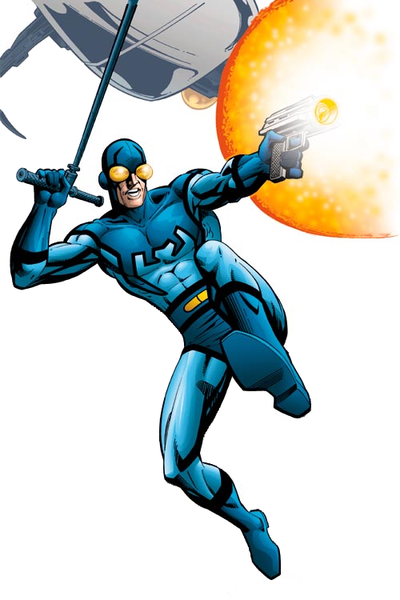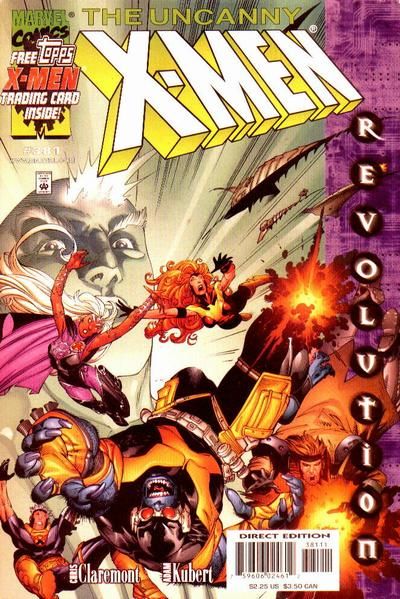Welcome to the latest installment of your breath of snark free air!
Enjoy!
COOL COMIC CHARACTER CONCEPT
Often, when a hero takes over for another hero, it is because they literally CAN fill the shoes of the earlier hero. For instance, when Barry Allen died, Wally West was truly able to fill Barry's shoes. The same when Bart Allen replaced Wally West.
But what if Wally West was charged with carrying on Barry Allen's legacy as the Flash withOUT powers?
Isn't that a cool concept?
Well, that's what Steve Ditko came up with when he created Ted Kord, the second man to call himself Blue Beetle.
Ted was a student of Dan Garrett, the original (and at the time, super-powered) Blue Beetle, and he enlisted Dan's help in investigating Ted's uncle, who turned out to be trying to take over the world. Dan and Ted intervened and stopped him, but not before Dan was killed. Dan asked Ted to keep up the Blue Beetle name, and Ted agreed, but Dan died before giving Ted any powers.
So there he was, charged with carrying on the legacy of a hero without any powers of his own - so Ted went out and used his technology know-how and his own natural athleticism to become the NEW Blue Beetle.
Another neat aspect of Ted's personality is that he was only doing this because A. A friend asked him and B. To do good. Ted did not have the same tragic background as some other heroes, so because of that, Ted had a whole different type of personality - one that is quite rare in comics.
Ted Kord - cool comic character concept.
SNARK-FREE CHALLENGE
Outside of their suits, who would win in a fight? Hellstrike (from Stormwatch) or Wildfire (from the Legion of Superheroes)?
COVER HOMAGE
One cool point to the first person who can tell me which cover this Uncanny X-Men cover is homaging!
Thanks to Chris for recommending this cover.
SNARK-FREE THEME DAY
Today's theme is "a traitor revealed!" Name examples of people on teams betraying the team.
1. Quicksilver betrayed the Avengers in the mid-80s, as he blamed them for everything bad in his life, but ultimately, he could not destroy them, what with his sister being an Avenger and all.
2. Mockingbird was sort of a traitor when she worked with the world governments to dismantle the Vision. She did not know it involved dismantling the Vision, but she must have known it wasn't going to be fun and games for the Vision.
3. Terra betrayed the Teen Titans by being aligned with Deathstroke to plot their capture.
4. The Thunderbolts had a fun twist when the "traitors" on their team were the ones who decided NOT to be bad guys.
5. The X-Men had a traitor, and it turned out to be Professor Xavier, whose mind had snapped when he mind-wiped Magneto (Magneto's evil personality merged with Xavier, driving Xavier batty).
6. The Justice League's official mascot, Snapper Carr, betrayed them to the Joker, and I do not recall him having a very good reason.
7. If the Suicide Squad counts, then Boomerang betrayed them every other issue...hehe.
8. Hal Jordan betrayed the Green Lantern Corps when he was possessed by Parrallax and forced to kill some Lanterns in his quest to gain the power of the Guardians (so he could fix Coast City).
9. Hawkman betrayed Justice League International when it was revealed that he was a spy by Thanagar.
10. Joystick recently betrayed the current Thunderbolts.
11. Black Widow and Hank Pym betrayed the Ultimates recently.
Any more?
THIS COMIC WAS GOOD
Warren Ellis' Global Frequency wa, one of the biggest "high concept" books (which is why it was shopped around for so long as a TV series).
The high concept is as follows. A woman runs an organization that is around the Globe, and has people who are "on the Global Frequency," ready to be called into service at a moment's notice when there is need for their particular brand of skill sets (or if they just happen to be the closest person to the action).
Like 100 Bullets (at least 100 Bullets initially), each story is a self-contained story with a rotating cast of characters, except the two constants in the series.
Miranda Zero - The head of the Global Frequency
Aleph - The woman with a "one in a million mind" who heads up the dispatch center of the Global Frequency, getting into contact with all the 1001 (current) members of the Global Frequency.
The other gimmick with this 12-issue mini-series, beside the rotating cast, is a rotating team of artists, one for each of the 12 issues.
Now, I'll detail what I thought of each issue (along with the artist for that particular issue).
#1 - Garry Leach - This was a great introduction into the world of Global Frequency. It demonstrated how these people are just normal human beings who just get called into duty as, well, basically superheroes. This story was a really good adventure yarn, as a former Russian agent, with a deteriorating device in his mind, poses a grave danger to everyone in America. The action goes at a breakneck pace, and the issue really epitomizes how it feels to be called out of nowhere to basically save two huge countries.
#2 - Glenn Fabry - The team is placed into a complex where a cyborg soldier is loose. Ellis has fun here making a "realistic" cyborg, and Fabry goes all out depicting what an actual cyborg would look like. The action goes a lot like an Alien movie, except for the amusing, black comedy ending. Nice issue.
#3 - Steve Dillon - One of those issues where a good 20% of the issue is spent explaining the idea used in the issue. In this issue, a memetics expert is the only hope of saving a neighborhood before drastic measures are taken, when a meme is loosed like a virus. The only hope? Codify human relationships as an equation. Should be no problem, right? Heh.
#4 - Roy A. Martinez - Probably the least acclaimed of the artists involved, this is just a flat out Die Hard-esque shoot 'em out involving two GF members, a cop and a secret agent against a group of terrorists. Martinez can draw some nice action, and that is what Ellis caters to.
#5 - Jon J. Muth - This is a supernatural/scientific issue, to explain what may have been a visiting by an angel in an Icelandic (at least I am pretty sure it was Iceland) town. Muth's art works perfectly for the sort of X-Files feel Ellis was going for in this issue.
#6 - David Lloyd - This was a fun story. The conceit is that the Global Frequency member at work in the issue is a "le parkour" expert. "Le parkour" is basically city running. Sorta like what Tarzan does through the trees, only in a city. The GF member spends the whole issue running the city like an obstacle course. It was a really fun issue, and Lloyd ably assists on pencils.
#7 - Simon Bisley - Another example of playing to the artist's strength. This issue, similar in nature to #4, involves the search for a terrorist in a building. It is SUPER (graphically) violent. But it is a well told story, with a fulfilling ending.
#8 - Chris Sprouse - Miranda Zero is kidnapped, and the GF only have about a little under an hour to save her. This was a really fun, old fashioned detective comic, deciphering the clues on the way to rescuing her. One of my favorites.
#9 - Lee Bermejo - This was a fairly depressing issue, reminiscent of Ellis' work on Stormwatch and Orbiter, going into the realm of deformities and freak experimentation. Bermejo knows how to draw dark stuff, so it works...but not a fun time.
#10 - Tomm Coker - I used to be a big Tomm Coker fan, but not so much as of late. In any event, this issue is just pretty much ENTIRELY just hand to hand between a GF member and a bad guy. There is a pretty twisted ending involving a...how should I say...unwanted amputation. But a pretty silly issue, overall.
#11 - Jason Pearson - This was a fun issue spotlighting Aleph, as we see how she joined the Global Frequency, and what happens when the bad guys come for HER. What happens when Aleph has to do something other than dispatch? I really dug Pearson's art.
#12 - Gene Ha - This issue tries to cap it all off, by basically redoing #1 (even some familiar faces from over the 12 issues stop by) in breakneck pace, but also taking the situation to TRULY global proportions (even OUTside the globe, as it were!). This was definitely a fun issue, as, like #1, when it ends - not only are the CHARACTERS exhausted, so is the reader!!!
So what did you guys think of the series?
Which was your favorite issue (mine was #6)?
Who was your favorite artist (mine was Pearson)?
Well, that's it for this installment of Snark Free Corner.
Hope you had fun!



